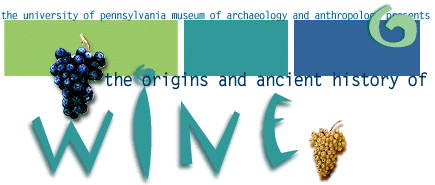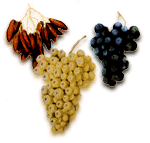 |
|||
 The grapevine, Vitis vinifera vinifera, showing three varieties of the domesticated grape: red, white, and blue. |
|
C
o n t e n t s :
|
|
The
Grapevine
![]()
Winemaking is very much constrained by the grapevine itself, even given the necessary containers and the means of preservation. The wild vine is dioecious (meaning it has unisexual flowers on separate plants that must be pollinated by insects). Only the female plant produces fruit. The wild grapevine grows today through the temperate Mediterranean basin, as well as in parts of western and central Asia. Sometime during the Neolithic Period, the wild Eurasian grapevine was eventually developed as our domesticated type. The domestic vine's advantages over the wild type can be traced to its hermaphrodism (bisexual flowers occur together in the same plant, enabling self-pollination by the wind and fruit production by every flower). The genetic "history" encoded in the DNA of modern wild and domesticated grapes, together with that of any available samples, suggests an alternative means to track the development of viniculture in the Old World. Using recombinant DNA techniques, it might be possible to delimit a specific region of the world and the approximate time period when the wild grape was domesticated. A "Noah" hypothesis would seek the progenitor(s) of modern domesticated grape varieties and their sequence of development and transplantation. (Noah, the biblical patriarch and "first vintner," is said to have planted a vineyard on Mount Ararat after the flood, later becoming drunk after he drank the fermented beverage.) |
|
|
|
|
|
|